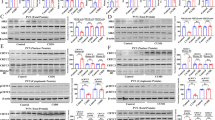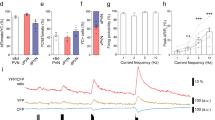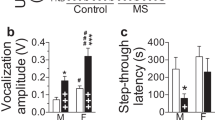Abstract
Corticotropin-releasing hormone (CRH) is a key neuroendocrine factor implementing endocrine, immune and behavioral responses to stress. CRH exerts its action through two major receptors, CRH-R1 and CRH-R2. Recently novel non-peptidic antagonists directed against CRH-R1 or CRH-R2 have been proposed as promising agents in the treatment of depression, anxiety and eating disorder. However, so far the CRH-receptor system has not been widely studied in humans. Therefore, we employed quantitative TaqMan PCR to analyze the expression and distribution of both CRH-R1 and CRH-R2 in human brain tissue and peripheral organs. Furthermore the expression of CRH receptors was analyzed for the first time in pituitaries of suicide victims by in situ hybridization and quantitative PCR. Our data demonstrated a different expression pattern in humans as compared to rodents. Both CRH-R1 and CRH-R2 were expressed in high amounts in the brain with the strongest expression in the pituitary. As described in rodents, however the CRH-R1 in human was the predominant receptor in the brain (82.7 ± 11.0%), whilst CRH-R2 was the predominant receptor in peripheral organs (77.0 ± 15.8%). There was a shift in the ratio of CRH-R1/R2 in the pituitaries of suicide victims. In conclusion, both CRH-R1 and CRH-R2 are widely expressed in human tissues with a distribution substantially different from rodents. Strong expression of both CRH-R1 and CRH-R2 in human pituitaries suggests that particularly under stress, activation of the HPA axis can be maintained through both receptors.
This is a preview of subscription content, access via your institution
Access options
Subscribe to this journal
Receive 12 print issues and online access
$259.00 per year
only $21.58 per issue
Buy this article
- Purchase on Springer Link
- Instant access to full article PDF
Prices may be subject to local taxes which are calculated during checkout




Similar content being viewed by others
References
Eckart K, Radulovic J, Radulovic M et al. Actions of CRF and its analogs Curr Med Chem 1999 6: 1035–1053
Elenkov IJ, Webster EL, Torpy DJ, Chrousos GP . Stress, corticotropin-releasing hormone, glucocorticoids, and the immune/inflammatory response: acute and chronic effects Ann N Y Acad Sci 1999 876: 1–11
Lovenberg TW, Liaw CW, Grigoriadis DE et al. Cloning and characterization of a functionally distinct corticotropin-releasing factor receptor subtype from rat brain Proc Natl Acad Sci USA 1995 92: 836–840
Stenzel P, Kesterson R, Yeung W, Cone RD, Rittenberg MB, Stenzel-Poore MP . Identification of a novel murine receptor for corticotropin-releasing hormone expressed in the heart Mol Endocrinol 1995 9: 637–645
Valdenaire O, Giller T, Breu V, Gottowik J, Kilpatrick G . A new functional isoform of the human CRF2 receptor for corticotropin-releasing factor Biochim Biophys Acta 1997 1352: 129–132
Di Blasio AM, Giraldi FP, Vigano P, Petraglia F, Vignali M, Cavagnini F . Expression of corticotropin-releasing hormone and its R1 receptor in human endometrial stromal cells J Clin Endocrinol Metab 1997 82: 1594–1597
Kostich WA, Chen A, Sperle K, Largent BL . Molecular identification and analysis of a novel human corticotropin-releasing factor (CRF) receptor: the CRF2gamma receptor Mol Endocrinol 1998 12: 1077–1085
Rodriguez-Linares B, Linton EA, Phaneuf S . Expression of corticotrophin-releasing hormone receptor mRNA and protein in the human myometrium J Endocrinol 1998 156: 15–21
Vaughan J, Donaldson C, Bittencourt J et al. Urocortin, a mammalian neuropeptide related to fish urotensin I and to corticotropin-releasing factor Nature 1995 378: 287–292
Chen R, Lewis KA, Perrin MH, Vale WW . Expression cloning of a human corticotropin-releasing-factor receptor Proc Natl Acad Sci U S A 1993 90: 8967–8971
Vita N, Laurent P, Lefort S et al. Primary structure and functional expression of mouse pituitary and human brain corticotrophin releasing factor receptors FEBS Lett 1993 335: 1–5
Liaw CW, Lovenberg TW, Barry G, Oltersdorf T, Grigoriadis DE, De Souza EB . Cloning and characterization of the human corticotropin-releasing factor-2 receptor complementary deoxyribonucleic acid Endocrinology 1996 137: 72–77
Webster EL, Lewis DB, Torpy DJ, Zachmann EK, Rice KC, Chrousos GP . In vivo and in vitro characterization of antalarmin, a nonpeptide corticotropin-releasing hormone (CRH) receptor antagonist: suppression of pituitary ACTH release and peripheral inflammation Endocrinology 1996 137: 5747–5750
Ehrhart-Bornstein M, Hinson JP, Bornstein SR, Scherbaum WA, Vinson GP . Intraadrenal interactions in the regulation of adrenocortical steroidogenesis Endocrinol Rev 1998 19: 101–143
Sanchez MM, Young LJ, Plotsky PM, Insel TR . Autoradiographic and in situ hybridization localization of corticotropin-releasing factor 1 and 2 receptors in nonhuman primate brain J Comp Neurol 1999 408: 365–377
Habib KE, Weld KP, Rice KC et al. Oral administration of a corticotropin-releasing hormone receptor antagonist significantly attenuates behavioral, neuroendocrine, and autonomic responses to stress in primates Proc Natl Acad Sci U S A 2000 97: 6079–6084
Zobel AW, Nickel T, Kunzel HE et al. Effects of the high-affinity corticotropin-releasing hormone receptor 1 antagonist R121919 in major depression: the first 20 patients treated J Psychiatr Res 2000 34: 171–181
Owens MJ, Nemeroff CB . Physiology and pharmacology of corticotropin-releasing factor Pharmacol Rev 1991 43: 425–473
Emeric-Sauval E . Corticotropin-releasing factor (CRF)—a review Psychoneuroendocrinology 1986 11: 277–294
Steckler T, Holsboer F . Corticotropin-releasing hormone receptor subtypes and emotion Biol Psychiatry 1999 46: 1480–1508
Gold PW, Goodwin FK, Chrousos GP . Clinical and biochemical manifestations of depression. Relation to the neurobiology of stress (2) N Engl J Med 1988 319: 413–420
Heinrichs SC, De Souza EB . Corticotropin-releasing factor antagonists, binding-protein and receptors: implications for central nervous system disorders Baillieres Best Pract Res Clin Endocrinol Metab 1999 13: 541–554
Wong ML, Licinio J, Pasternak KI, Gold PW . Localization of corticotropin-releasing hormone (CRH) receptor mRNA in adult rat brain by in situ hybridization histochemistry Endocrinology 1994 135: 2275–2278
Vale W, River C, Brown MR et al. Chemical and biological characterization of corticotropin releasing factor Recent Prog Horm Res 1983 39: 245–270
Insel TR, Aloi JA, Goldstein D, Wood JH, Jimerson DC . Plasma cortisol and catecholamine responses to intracerebroventricular administration of CRF to rhesus monkeys Life Sci 1984 34: 1873–1878
Wong ML, Kling MA, Munson PJ et al. Pronounced and sustained central hypernoradrenergic function in major depression with melancholic features: relation to hypercortisolism and corticotropin-releasing hormone Proc Natl Acad Sci U S A 2000 97: 325–330
Timpl P, Spanagel R, Sillaber I et al. Impaired stress response and reduced anxiety in mice lacking a functional corticotropin-releasing hormone receptor Nat Genet 1998 19: 162–166
Smith GW, Aubry JM, Dellu F et al. Corticotropin releasing factor receptor 1-deficient mice display decreased anxiety, impaired stress response, and aberrant neuroendocrine development Neuron 1998 20: 1093–1102
Coste SC, Kesterson RA, Heldwein KA et al. Abnormal adaptations to stress and impaired cardiovascular function in mice lacking corticotropin-releasing hormone receptor-2 Nat Genet 2000 24: 403–409
Iino K, Sasano H, Oki Y et al. Urocortin expression in the human central nervous system Clin Endocrinol (Oxf) 1999 50: 107–114
Willenberg HS, Bornstein SR, Hiroi N et al. Effects of a novel corticotropin-releasing-hormone receptor type I antagonist on human adrenal cells Mol Psychiatry 2000 5: 137–141
Marshall GD Jr, Agarwal SK . Stress, immune regulation, and immunity: applications for asthma Allergy Asthma Proc 2000 21: 241–246
Chrousos GP . The role of stress and the hypothalamic-pituitary-adrenal axis in the pathogenesis of the metabolic syndrome: neuro-endocrine and target tissue-related causes Int J Obes Relat Metab Disord 2000 24 Suppl 2: S50–S55
Fukudo S, Nomura T, Hongo M . Impact of corticotropin-releasing hormone on gastrointestinal motility and adrenocorticotropic hormone in normal controls and patients with irritable bowel syndrome Gut 1998 42: 845–849
Slominski AT, Botchkarev V, Choudhry M et al. Cutaneous expression of CRH and CRH-R. Is there a ‘skin stress response system?’ Ann N Y Acad Sci 1999 885: 287–311
Willenberg HS, Bornstein SR, Dumser T et al. Morphological changes in adrenals from victims of violent suicide in relation to altered apoptosis Endocr Res 1998 24: 963–967
Lopez JF, Palkovits M, Arato M, Mansour A, Akil H, Watson SJ . Localization and quantification of pro-opiomelanocortin mRNA and glucocorticoid receptor mRNA in pituitaries of suicide victims Neuroendocrinology 1992 56: 491–501
Nemeroff CB, Krishnan KR, Reed D, Leder R, Beam C, Dunnick NR . Adrenal gland enlargement in major depression. A computed tomographic study Arch Gen Psychiatry 1992 49: 384–387
Acknowledgements
This study was supported by grants of the Deutsche Forschungsgemeinschaft (BO 1141/7-1) and Deutsche Krebshilfe (10-1662-RE2) to SRB and Japan Society for the Promotion of Science to NH. We are grateful to Peter Bongiorno. JL is supported by NIH grants U01GM61394, K30HL04526, R01DK58851 and by awards from the Dana and Stanley Foundations. M-LW is supported by NIH grant P50AT00151 and by a NARSAD award.
Author information
Authors and Affiliations
Corresponding author
Rights and permissions
About this article
Cite this article
Hiroi, N., Wong, M., Licinio, J. et al. Expression of corticotropin releasing hormone receptors type I and type II mRNA in suicide victims and controls. Mol Psychiatry 6, 540–546 (2001). https://doi.org/10.1038/sj.mp.4000908
Received:
Revised:
Accepted:
Published:
Issue Date:
DOI: https://doi.org/10.1038/sj.mp.4000908



